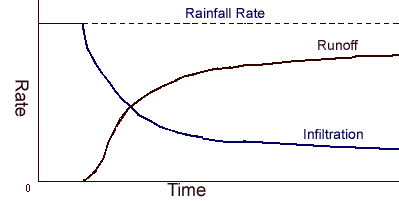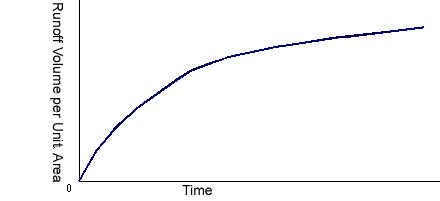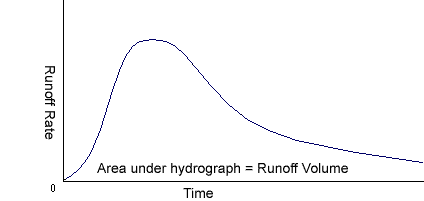| |
Runoff Basics
Runoff is that portion of precipitation that flows over land surfaces toward larger bodies of water. Before runoff can occur, rainfall must satisfy the immediate demands of infiltration, evaporation, interception, surface storage, surface detention and/or channel detention. Some are very minor losses, e.g., interception by a corn crop is only about 0.02 inches. However, in a forested area interception may not be minor, accounting for up to 25 percent of the rainfall. For short time periods (storms) on agricultural lands:
- rainfall - runoff = infiltration
This can be illustrated by a hydrograph with a steady rainfall input:

Notice that runoff is an approximate mirror image of infiltration (with some additional time-lag for overland flow travel lag).
Factors Affecting Runoff:
There are two broad categories of factors that control runoff: rainfall (storm) characteristics and watershed physical conditions. Important rainfall characteristics include duration, amount, intensity and distribution. Key watershed factors are:
-
Size
- For a fixed return interval, as watershed size increases, the runoff
per unit area decreases. This occurs primarily because average
rainfall amount decreases with increasing area; secondarily, increased travel
time for runoff allows more infiltration and other losses.

-
Shape
- For equal sized watersheds, runoff decreases as overland flow length increases. This results from the increased time of concentration. Longer duration storms, needed to produce runoff from all points in watershed, have lower average intensities.
-
Topography
- Surface slopes and roughness greatly influence runoff. Seep slopes reduce time of concentration and detention volume. Roughness increases surface storage and promotes greater infiltration, both of which decrease runoff.
-
Soils
- Watershed soils influence infiltration and deep seepage rates. Infiltration must be satisfied before runoff begins.
-
Surface culture
- Modern agricultural practices promote infiltration, slow runoff and reduce the antecedent water content of soils prior to a storm event.
Runoff hydrograph:
A graph of runoff rate vs. time is called a runoff hydrograph. The shape of a hydrograph depends on the time distribution of rainfall and upon watershed flow characteristics. However, most hydrographs bear some resemblance to the "typical shape" shown below:

The receding limb of a hydrograph usually extends over a longer period of time than the rising limb. The area under the curve gives the volume runoff (volume/time x time = volume). In this course, we will primarily use the peak runoff rate in our problems. Since hydrographs of previous storm events are seldom available for small watersheds, estimates of peak rates and/or volume must be made using computational models rather than from statistical analyses of past records.